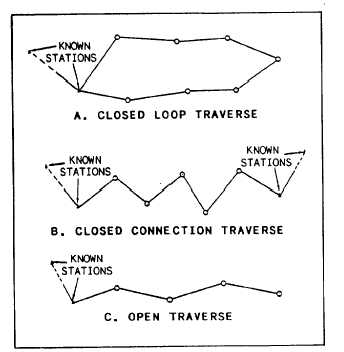graphite be used to lubricate transit moving parts
when the transit is to be used in sub-zero
temperatures instead of the light film of oil
(preferably watch oil) when its use is confined to
an area with normal weather conditions. The
lubricant should be applied thinly to avoid
making the lubricated parts an easy repository for
dust or catcher of dust.
Consult the manufacturer’s manual or your
senior EA whenever you are in doubt before
doing anything to an instrument.
NOTE: Information on tests, adjustments,
and minor repairs of surveying instruments will
be presented at the EA2 level.
TRAVERSE OPERATIONS
(FIELD PROCEDURES)
A survey traverse is a sequence of lengths and
directions of lines between points on the earth,
obtained by or from field measurements and used
in determining positions of the points. A survey
traverse may determine the relative positions of
the points that it connects in series; and, if tied
to control stations based on some coordinate
system, the positions may be referred to that
system. From these computed relative positions,
additional data can be measured for layout of new
features, such as buildings and roads.
Traverse operations (actions commonly called
TRAVERSING) are conducted for basic area
control; mapping; large construction projects,
such as military installation or air bases; road,
railroad, and pipeline alignment; control of
hydrographic surveys; and for many other
projects. In general, a traverse is always classified
as either a CLOSED TRAVERSE or an OPEN
TRAVERSE.
A closed loop traverse (fig. 13-29, view A),
as the name implies, forms a continuous loop,
enclosing an area. This type of closed traverse
starts and ends at the same point, whose relative
horizontal position is known. A closed connecting
traverse (fig. 13-29, view B) starts and ends at
separate points, whose relative positions have been
determined by a survey of an equal or higher order
accuracy. An open traverse (fig. 13-29, view C)
ends at a station whose relative position is not
previously known, and unlike a closed traverse,
provides no check against mistakes and large
errors. Open traverses are often used for
preliminary survey for a road or railroad.
Figure 13-29.-Types of traverses.
The order of ACCURACY for any traverse
is determined by the equipment and methods used
in the traverse measurements, by the accuracy
attained, and by the accuracy of the starting and
terminating stations. Hence, the order of accuracy
must be specified before the measurements are
started. For engineering and mapping projects,
the distance measurement accuracy for both
electronic and taped traverses for first, second,
and third order are 1/35,000, 1/15,000, and
1/7,500, respectively.
For military use such as field artillery, lower
order accuracies of fourth, fifth, and sixth are
1/3,000, 1/1,000, and 1/500, respectively. The
order referred to as lower order is applied to all
traverses of less than third order.
To accomplish a successful operation, the
traverse party chief must ensure that initial
preparations and careful planning are done before
the actual traversing begins. In the remainder of
this chapter, we will discuss some of the basic
procedures normally undertaken by a transit-tape
traverse party.
ORGANIZING THE PARTY
A traverse party may vary from 2 to about 12
personnel, all under the supervision of a traverse
13-27


